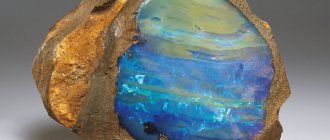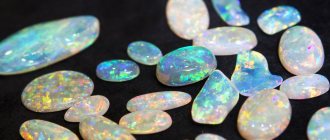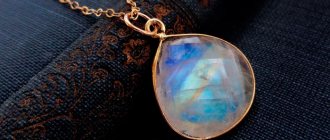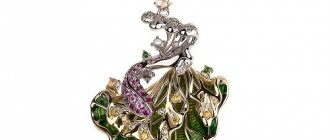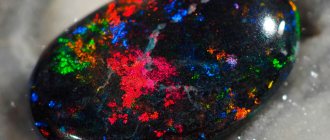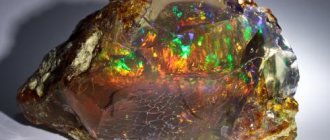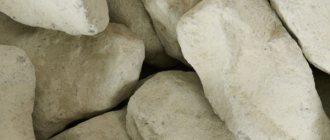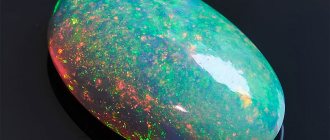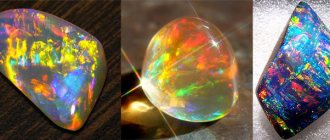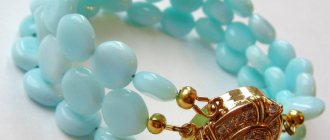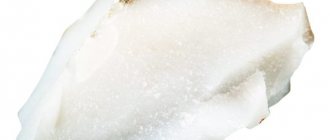There were legends about the properties of opal. Nowadays it is still used by jewelers, and not only them. With the help of the mineral, lithotherapists treat diseases, and magicians, as in the old days, try to penetrate the deep secrets of the universe. But in order for the stone to help you, you need to be among those to whom it suits their character and zodiac sign. Well, first things first.
History of the stone
The only continent on Earth where there are no legends about the origin of opal is Antarctica. And this is only because there is no indigenous population there, with the exception of penguins.
In Ancient Greece they said that Zeus fought with the Titans, and was happy when he won a difficult battle. The tears of joy that the thunder god shed fell to the ground and turned into opals. The Hellenes believed that with the help of a gem you can discover the gift of clairvoyance.
The indigenous peoples of Australia also associated the crystal with their supreme god. According to their mythology, opals are traces of the Creator of the world, who once came to earth to see how people live.
Arab sages believed that the stone was formed where lightning struck the ground. Believing that celestial electricity did not hit the same place twice, they used the crystal as protection from thunderstorms. So among Arabic talismans our mineral takes pride of place.
According to Indian legend, the goddess of the rainbow scattered into gems to escape her annoying admirers. By the way, the pebble owes its modern name to the Indians.
In Sanskrit, the word "upala" means any precious crystal at all.
In medieval Europe, it was believed that the gem could bring good luck. But there was one variety of it, which was attributed exclusively negative properties. This is a black opal, reminiscent of the color of the night sky. They said that it was used by witches and evil magicians at their sabbaths.
The peoples of America also used the iridescent gem. The eyes of skillfully made idols were made from it. It was believed that believers, peering into the play of light in the depths of the stone, would be able to hear the voice of God, recognize his will and change their lives.
Where is it mined?
Most often, stone deposits look like biconvex lenses or veins in the thickness of other rocks. Large deposits are rarely found. Today, the main supplier of gems is Australia. The reason here is not only because of particularly large reserves, but also because opal mining has been going on for a very long time. Intensive development led to the fact that the mines in Europe, Asia and northern Africa were almost completely exhausted by the 19th century.
Approximately 90% of Australian gems are white crystals of varying transparency. The “capital” of stone mining is the city of Coober Pedy, South Australia. In the state of Queensland there are deposits of the boulder class mineral. And finally, the village of Lightning Ridge in New South Wales boasts a deposit of the rarest black specimens.
The leader in the production of these gems is Australia.
Other countries also supply the market with unprocessed opal, although in much smaller quantities. Gem deposits outside the kangaroo continent are known in the following countries:
- Mexico (Yucatan Peninsula);
- Honduras;
- Guatemala;
- Peru;
- United States of America, Nevada;
- Japan;
- Slovakia;
- Türkiye;
- Kazakhstan.
Fire opals, one of the rarest varieties of gemstone, are sometimes found in these countries. Stone is also found in Kamchatka and Transcarpathian Ukraine, but full-scale development of deposits in these regions is not carried out.
Features of opal
The mineral has an amorphous structure. Some of them may contain up to 10% water. The ancient Romans called opal “enchanting the eyes” because of the peculiar play of colors. rainbow tints in it .
The color range of the stone is very wide, but the most common are blue and milky options. Black, harlequin, red and yellow are found less frequently and are valued higher .
Some types of opal are fragile and soft, so they are used only in earrings and pendants. Stones of Ethiopian origin are considered the most durable. High-quality minerals are also mined in Australia.
Synthetic opals are often used in the jewelry industry.
The play of light is the main characteristic of the stone. The better it is visible, the higher the quality and price. Cheap products use either synthetic stones or only the surface is decorated with opal plates.
Varieties
The color of opal cannot be described in one sentence. The variety of shades is very large. Depending on how rich the color is and how pronounced the play of light is in the stone, jewelers divide gems into precious, semi-precious and ornamental.
The first category includes transparent specimens with pronounced opalescence (play of a light beam). Other crystals are considered semi-precious. They make simpler jewelry. They are also used as part of doublets, protecting more expensive varieties with plates from cheaper ones. And finally, faded and colorless stones play the role of ornamental stones, as well as materials for room decoration. Such gems include, for example, semi-opals - brown or yellow opaque minerals with a greasy sheen.
Noble opals
By precious varieties of gems, jewelers mean the following:
- Fire (Mexican) opals. These are minerals of rich red or orange color, with a pattern that resembles flames. They are mined, as the name suggests, in Central America.
- Black opals. Expensive and very rare gems. The dark stones are reminiscent of space in their hue. Any jeweler will happily take on a dark purple specimen.
- Harlequins. They were named after the character of the Italian folk theater, whose clothes were sewn from multi-colored pieces of fabric. These are gems with a beautiful polychrome pattern. The pattern on them consists of circles and squares in blue, green and red, which shimmer depending on the change in viewing angle.
- Another multi-colored variety is proudly called “royal opal.” Their core is bright red or bronze in color, and is surrounded by a green border. The outer edge of the mineral is completely devoid of color.
- Jirasols, or sky opals, are minerals that have a blue tint.
- Lechos opals are sea-green stones with deep carmine and green tints.
"Cat's eyes". Rare and expensive specimens of honey or golden color. Their distinctive feature is a vertical narrow black stripe in the middle of the stone.
The most expensive varieties are black stones, despite the superstitions that surround them. Royal (royal) opals are also highly valued. The cost of a gem increases depending on its size, usually exponentially. This means that a 3-carat piece will be at least twice as expensive as a two-carat piece.
Common opals
We have separate articles about many semi-precious and ornamental varieties of gems. They are often very different from their noble counterparts not only in transparency and play of light, but also in magical properties.
- Hyalites. These are colorless, watery and transparent crystals, similar to glass. They form growths in the form of clusters in places where there is very high humidity.
- Chrysopals are green opals that resemble apples in color.
- Moss gems are opaque white minerals with a pattern that resembles grass or moss.
- Peruvian blue opals are the “younger brothers” of celestial jirasols; they differ from them in the lack of play of light.
- Resin opals are matte black crystals.
- Cacholongs, or pearl opals. White gems with dark veins. In India, a legend is told about them that these stones appeared from the milk of sacred cows that spilled onto the ground. That's why they are also called dairy products.
- Irisopals are a colorless or brownish rock that is marketed in Mexico.
- Wax (yellow opals).
- Hydrophanes (water gems). Porous stones that become transparent when soaked in water. When precious specimens grow old, they turn into this particular subspecies.
- Wood (dendritic) stones. A species that occurs when a mineral replaces rotting wood. These crystals combine a whitish “opal” color with a wood-like structure.
Specimens that are natural doublets are called boulders. These are crystals where two rocks coexist, precious and ordinary. The most beautiful among them are the “rainbow” koroites, shimmering in dozens of shades. Iowa nuts are also interesting. This is the name given to stones where a noble variety is surrounded by a cheaper rock.
Physico-chemical properties of stone
| Property | Description |
| Formula | SiO2 nH2O |
| Impurities | Fe2O3, MgO, CaO |
| Hardness | 5,5 — 6,5 |
| Density | 1.96 - 2.20 g/cm³ |
| Refractive index | 1,44 — 1,46 |
| Kink | Conchoidal. |
| Fragility | Fragile. |
| Cleavage | Absent. |
| Birefringence, dispersion, pleochroism | None. |
| singonia | Amorphous. |
| Shine | Glassy, greasy, waxy, pearlescent, dull. |
| Transparency | From transparent to translucent. |
| Color | White, yellow, red, orange, brown, blue, green, black. |
How to distinguish opal from a fake
Natural opal can be very expensive, especially if it is a noble variety. Fraudsters have invented several ways to counterfeit precious varieties of gems:
- The simplest and cheapest is to imitate a mineral using plastic or glass.
- Selling cheap varieties under the guise of expensive ones. For example, resin stone is passed off as an elite “night stone”.
- Doublets and triplets. A thin plate of a noble variety is glued with one or two plates of an ornamental variety.
- Artificial stones. They tried to grow crystals in the laboratory back in the 19th century. The breakthrough came in 1972. It was then that chemically produced Gilson opals entered the market.
Artificial stone is no worse in appearance and even in composition than natural stone.
But it’s unlikely to be suitable for healing and magic. It should be remembered that a plastic fake, like a synthetic opal, does not have the magical and healing properties of the original. Fortunately, it is quite easy to distinguish a fake if you remember the basic properties of the gem.
First of all, you need to pay attention to what the opal stone you are going to buy looks like. A genuine gem is distinguished by “floating” lights. If you look at it from a different angle, they will change their position in the thickness of the crystal. In a laboratory mineral, the sparks are always motionless.
The price of opal can also say a lot. Jewelry with a night or fire gem is unlikely to cost less than a thousand rubles. These are very rare varieties of the mineral, and jewelers and miners value their work quite highly.
Application and care
Products made from opal are as diverse as the mineral itself. Jewelry is made from noble varieties by setting them in precious metals. Cheaper stones are also used for rings and bracelets. Ornamental varieties become material for figurines, tabletops and vases. The cheapest subspecies are used to make facing tiles.
To ensure that your stone lasts as long as possible, you must remember that opal is one of the most fragile minerals. The thing is, it's not even a crystal in the scientific sense. Each specimen consists of tiny globules, which are welded together extremely weakly. However, if you follow simple wearing rules, then nothing bad will happen to the gem.
- The stone must be protected from impacts, shocks and friction.
- If you need to clean opal jewelry, use soapy water and a soft toothbrush. After removing dirt and dust, wrap the gem in a napkin and leave in a sunny place for an hour.
- Do not keep the mineral in direct sunlight for a long time. It may lose color or even crack. If this happens, immerse the stone in water at room temperature for a couple of hours.
- Remove rings and bracelets when you start cleaning. Contact with detergents, especially alkaline ones, can cause irreparable damage to the crystal.
- Keep your jewelry wrapped in soft cloth in a cool, dark place.
A careful attitude is the main condition for “tuning” your opal to the right wave. The magical properties of a mineral that is in harmony with your soul will be maximum.
Deposits and stone mining
The mineral in the form of thin veins and biconvex lenses is found in the thickness of other rocks. Up to 90% of gems are found in Australia, where complex geological processes took place in ancient times.
The development of deposits here began relatively recently. Most stones mined in Australia are white, but specimens of other colors are also found. They differ in the degree of transparency and severity of opalescence. In other regions, deposits are already severely depleted.
Good specimens are found in the following areas:
- Egypt;
- Honduras;
- USA;
- Japan;
- Slovakia;
- Guatemala;
- Brazil;
- Mexico;
- India;
- Kazakhstan;
- Ukraine;
- Turkey.
In Russia, high-quality stones are found only in Kamchatka. Here, small deposits are present in areas of active or already extinct geysers.
Kamchatka land with opals.
Medicinal properties
Opal is used to treat diseases of the cardiovascular system and nervous disorders.
Opal stone has been used to treat many diseases since ancient times. Thus, it was believed that it was able to neutralize poisons, stop bleeding, and protect against plague. Lithotherapists of our time use all varieties of the mineral in the following areas:
- Normalization of the emotional background. Peruvian and heavenly minerals are excellent talismans for meditation. They are able to heal anxiety, nervousness, and normalize sleep. All precious varieties help get rid of depression and melancholy.
- Treatment of diseases of the cardiovascular system. Pink or red opal will help for this. To normalize blood flow and blood pressure, reduce the development of atherosclerosis and the frequency of angina attacks, you need to wear a bracelet with a stone on your left wrist.
- Improved vision. Massaging the eyebrows with a green gem helps get rid of eye fatigue and spasm of accommodation.
- Treatment of diseases of the gastrointestinal tract. Precious varieties of stone relieve symptoms of stomach ulcers, gastritis, relieve nausea, heartburn and heaviness in the abdomen.
Separately, it should be said about fire opal. It is difficult to overestimate its importance for a person who is weakened after a long illness or suffers from chronic fatigue. Meditation on the flames in the depths of the stone helps to restore vigor, increase efficiency, and relieve irritability after a hard day.
Jewelry
In total, there are about one hundred types of natural opal - its color range is rich in shades of all the colors of the rainbow. Precious stones include transparent stones of milky white and blue colors, the rest are considered semi-precious. But in terms of effectiveness and beauty, not a single color is inferior to each other.
The most common minerals are the following colors:
- black - noble - can be cast in 2-3 shades, or in all colors at the same time. Perhaps the most beautiful and expensive type of opal;
- black with star-shaped iridescence - matrix;
- white, white-blue, milky, transparent;
- fiery with a wine-yellow or red tint;
- completely transparent – hyalite;
- transparent cloudy – hydrophane;
- brown-black with splashes - Baudelaire;
- transparent with a blue tint – jirakhzol;
- bright red in the center and green around the edges - royal;
- opaque pearl (porcelain) – cacholong;
- iridescent with triangular mosaic – harlequin;
- dark opal with blue, purple and red veins - Australian.
Magic properties
The meaning of opal in the magic of gems is the revelation of a person’s internal reserves, the realization of the wearer’s most hidden passions and desires. Only strong-willed, creative and resourceful people will be able to find harmony with the mineral. For others, it will become just another decoration.
The mineral is able to protect its owner from negative energy, the evil eye, damage and love spells.
The stone also reveals the gift of foresight and enhances intuition. But only people with pure thoughts should wear it. The fact is that the crystal enhances all the emotional impulses of the owner. Black opal is especially famous for this. This gem is capable of drawing out the most hidden aspirations from the depths of the subconscious, but is also considered the most powerful amulet.
The mineral has a strong protective effect against the evil eye, poison and other evils.
White stones have a completely opposite character. These are the best amulets for healers, nurses and nannies. They enhance good character traits and make the wearer more tolerant and calmer. Blue and blue opals can strengthen marriage and friendship, protect against failures and temptations.
Fire stones affect women and men differently. Representatives of the stronger sex under its influence will become braver, more decisive and tougher. The fair half of humanity will notice that the crystal has made them wiser, calmer and more tolerant. The gem will help you find a couple for a serious relationship and achieve reciprocity. The magical properties of opal are also used in rituals aimed at attracting money, good luck, and happiness in your personal life.
Interesting Facts
There are many interesting facts associated with opal:
- The largest opal in the world, called the Australian Olympic opal, was found in 1956 in the vicinity of Coober Pedy in Australia. It weighed 17 thousand carats, or 3450 g. It is stored in Melbourne.
- NASA scientists have identified traces of opals on Mars.
- In 1909, a reptile skeleton was discovered in Australia, in which precious opals replaced the bone tissue.
- A number of jewelry and decorative items made from opal were discovered in the tombs of the pharaohs.
The rainbow shine of the gem is mesmerizing, so many legends and myths are associated with it. He was highly valued by royalty and nobles in different eras. It was believed that if you look at the mineral for a long time, you can comprehend the secrets of the universe.
Who is suitable according to their zodiac sign?
A universal gem is blue or white opal. Its properties are suitable for any zodiac sign. However, astrologers recommend it primarily to fire signs - Leo , Sagittarius and Aries . Such a mineral will smooth out their natural shortcomings, balance their inherent stubbornness and tendency to take unnecessary risks. However, Aries should avoid dark-colored crystals.
Libra , Gemini and Aquarius will appreciate fire gems. They will make them braver, more determined and bolder. Scorpios , Pisces , Cancers are suitable for opals of dark shades, which will enhance the intuition and creative abilities of their bearers.
Capricorns , Virgos, Taurus are those who are suitable for opal of yellow shades. Such stones will help them improve their health, become stronger and more resilient. At the same time, an amber gem will make such a person more active and increase his initiative. For those representatives of the signs who are engaged in creativity, the crystal will serve as a source of inspiration.
